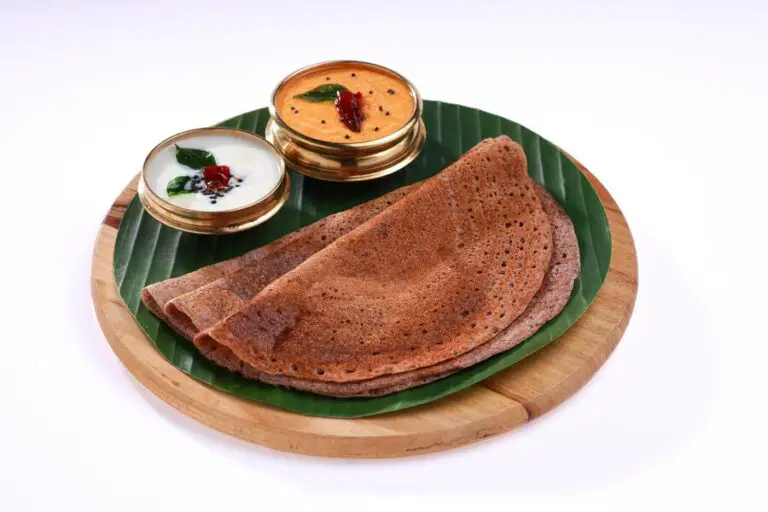Ragi is a wonderful ingredient that became outdated when wheat and rice grew increasingly prevalent. Nevertheless, this ancient millet that has been ignored for centuries is gradually returning as the most recent.
DESI SUPERFOOD!
Several names in many languages are known as Ragi. For example, in India, finger millet is called ragi (Kannada, Hindi, and Telugu), Kodra (Himachal Pradesh), Mandia (Oriya), Taidalu (Telangana), and Nachni (Marathi).
Ragi can be used in a wide variety of different dishes. Breakfast can include ragi dosa. It is a filling breakfast and quick to make.
Diet balance is also important. Weight loss is another benefit. South Indian ragi dosa can be made at home for breakfast, lunch, and dinner. It is healthy and easy to make.
Ragi—What Is It?
Finger millet is Ragi. South India and several African nations eat it. It is considered a weight-loss wonder grain. Calcium and fibre are abundant in them. Therefore, it is the best diabetes treatment. In southern India, it is a favourite baby meal. Baby ragi porridge aids digestion from 28 days old. Calcium and iron from this will strengthen the baby's bones.
This perennial grass is named Gramineae because its grain head has five spikes. 1–2m tall.
Green, thin leaves are 30–70 cm long. Straight or curving branches hold brown, red, or purple seeds in florets.
Ragi's Nutrition
Ragi is rich in vitamins, minerals, and macronutrients like carbohydrates, fibre, lipids, and proteins. In addition, its low cholesterol and salt levels promote heart health.
Vitamins C and E in ragi boost immunological, skin, and hair health.
Ragi flour has high B-complex vitamin levels. In addition, its calcium, magnesium, iron, and phosphorus make it a healthy breakfast cereal and superfood.
Ragi's 100-gram nutritional value.
Macronutrients
- Calories-385 kcal
- Fat-7%
- Carbohydrates-25%
- Fibre-14%
- Protein-10%
Micronutrients
Minerals
- Calcium-26%
- Iron-11%
- Potassium-27%
Vitamins
- Thiamine-5%
- Riboflavin-7.6%
- Niacin-3.7%
- Folate-3%
- C-7%
Health Advantages Of Ragi
1. Organic Breakfast
Ragi contains vitamins C, E, B-complex, iron, calcium, antioxidants, proteins, fibres, enough calories, and necessary unsaturated fats.
2. It Supplies Amino Acids.
Ragi is a plant-based protein source with particular amino acids. For example, it has the amino acid methionine, which is made of sulphur and helps skin and hair get back to being healthy.
3. Gluten-Free
Unfortunately, many people are allergic to wheat, a significant element in Indian food. Gluten-free ragi can replace wheat. Ragis fibre aids digestion. However, digestive problems and gluten sensitivities prevent nighttime ragi use.
4. Strengthens bones.
It strengthens bones with calcium. It helps with osteoporosis. Younger people can eat ragi daily, but middle-aged and older people must eat ragi in measured amounts to improve bone health and avoid GI and kidney problems.
5. Maintains Blood Sugar
Finger millet includes phytates, tannins, and polyphenols, which impede digestion. Ragi decreases blood sugar, making it useful in a diabetes diet. Due to its high fibre content and low digestion,
6. Treats anaemia
Anaemia affects lakhs of Indian men, women, and children yearly, causing weariness and poor productivity. Anaemia can be treated with ragi, an iron-rich meal.
7. Improves Nervous System
Ragis' high tryptophan content improves nerve impulse transmission, brain memory, and relaxation. Ragi also helps anxiety and insomnia because tryptophan regulates serotonin, a neurotransmitter.
8. Helps Heart
Ragi is cholesterol-free. Heart patients can safely eat ragi flour dishes. Dietary fibre and vitamin B3 (niacin) boost HDL and lower LDL. This prevents heart vessel plaque and fatty deposits, enhancing heart muscle performance and health.
9. Pregnancy And Lactation Ragi
Pregnant and lactating women benefit from overnight ragi sprouts. Ragis' rich iron and calcium content helps pregnant and young moms produce milk and balance hormones.
Recipe For Ragi Dosa
This easy dosa dish can be done anytime. With chutney and sambar, ragi dosa is crispy. This recipe is quite healthy.
Ingredient
- Ragi flour—2 cups
- Urad dal flour—2 tsp
- 6 finely chopped green chillies
- Onion—2 medium-sized minced
- Cumin seeds—2 tsp
- Required refined oil
- Rice flour—2 cups
- Semolina—2 tsp
- 2″ chopped ginger
- Coriander leaves—1 cup finely chopped
- Buttermilk—1/2 cup
- Salt—2 pinches
Preparation
- To create this scrumptious dosa, mix ragi flour, rice flour, urad dal flour, semolina, and salt in a basin. Mix in the rest. Pour water to thin the batter.
- Warm a flat pan. Spread batter over it with a spoon. Oil both sides and fry till light brown. Serve with sambhar and chutney.
Ragi Dosa Calories
- Calories-137 kcal
- Fat-3.22 g
- Carbohydrates-23.9 g
- Protein-3.95 g
- Sodium-424 mg
- Potassium-171 mg
Dietitian Advice
All ages can eat ragi. Gluten-free Ragi is nutritious and gluten-free. Thus, it is perfect for fitness buffs and those who desire to eat healthy daily.
Conclusion
Anyone can eat Ragi. Those with gluten or cereal allergies can eat it without worry because it is gluten-free and contains all the vital elements, including fibre, protein, iron, calcium, antioxidants, and vitamins.
Like all foods, ragi should be eaten in moderation to avoid health problems. However, in moderate levels, ragi may prevent malnutrition and degenerative disorders like osteoporosis and arthritis. Add this to rots, dosa, and halwa for health advantages.
0






